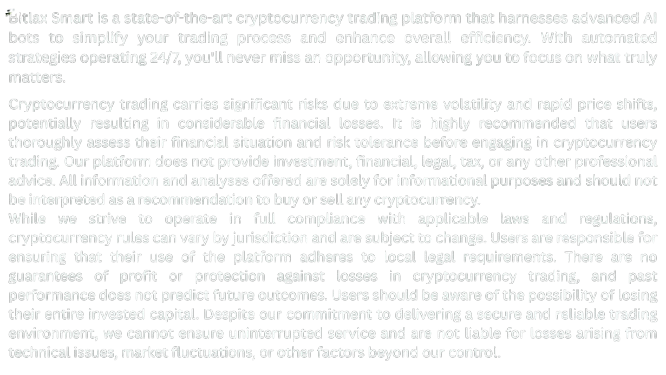Introduction
Using crypto bots makes trading more efficient — but when it comes to taxes in Australia, it can get messy fast if you’re not prepared.
Unlike passive investing, automated trading may trigger frequent taxable events, and if you’re not tracking them properly, the ATO (Australian Taxation Office) won’t be impressed.
In this guide, we break down exactly how to manage your trading bots on platforms like Bitlax Smart while staying compliant with Australian tax laws — no legalese, just plain talk.
🧾 Crypto Tax Basics in Australia
According to the ATO, crypto is treated as property, not currency. That means:
- Every disposal (sell, swap, trade) is a capital gains tax (CGT) event
- Even bot trades are treated like your own actions
- You must report gains/losses in AUD
- Long-term CGT discounts may apply
“Yes, your bot’s trade every 4 minutes is a taxable event. Every. Single. Time.”
🤖 What Bot Activity Is Taxable?
| Bot Action | Taxable? | Reason |
|---|---|---|
| Buying BTC | ❌ | Not a disposal |
| Selling BTC for USDT | ✅ | Disposal event |
| Swapping ETH for BNB | ✅ | Disposal & acquisition |
| Earning rewards via bots | ✅ | Treated as income |
| Transferring between own wallets | ❌ | No disposal (but must be tracked) |
🧠 Common Mistakes Crypto Traders Make
- Not keeping trade records
- Assuming bots aren’t taxable
- Failing to convert PnL to AUD
- Mixing personal and bot funds
- Missing staking/income classification
🧰 Tools You’ll Need
📌 From Your Bot Platform (e.g., Bitlax Smart):
- Trade logs with timestamps
- Profit/loss reports
- Export to CSV/Excel
- Token pair data
📌 From a Crypto Tax Software:
| Tool | Function |
|---|---|
| Koinly | Australia-specific CGT calculator |
| CryptoTaxCalculator.io | Imports from exchanges and bots |
| CoinTracking.info | Tracks bot + manual trades |
| CoinLedger | Income + CGT reporting |
📋 Step-by-Step: Making Your Bot Trades Tax-Ready
Step 1: Turn on Trade Logging
Enable full logging in your Bitlax Smart dashboard for every bot.
Step 2: Export Trade Data Monthly
Export all trades into CSV at the end of each month. Keep backups.
Step 3: Label Trade Types
Separate:
- Spot trades
- Income (if earned through staking/yield)
- Transfers (for tracking only)
Step 4: Convert All Trades to AUD
Use ATO-endorsed exchange rate converters or automated tools.
Step 5: Upload to Tax Platform
Feed your data into Koinly or similar and cross-check the generated CGT.
💸 Capital Gains Explained (Simple Version)
| Example | Outcome |
|---|---|
| Buy ETH at $2,000, Sell at $2,400 | $400 gain = CGT event |
| Trade BTC → SOL | BTC sold (gain/loss), SOL acquired |
| Holding crypto > 12 months | May qualify for 50% CGT discount |
🧾 Income vs Capital Gains: Know the Difference
| Source | Tax Type |
|---|---|
| Regular bot trading | Capital Gains Tax |
| Bot-generated staking/yield | Income Tax |
| Airdrops or bonuses | Income Tax |
| NFT flips | Capital Gains or Business Income (case-by-case) |
📅 Tax Time Checklist (for Bot Users)
✅ Export all trades from Bitlax
✅ Confirm AUD values
✅ Run CGT & Income reports
✅ Declare crypto totals on your personal tax return
✅ Save all backups (ATO can request data for 5 years)
🙋♂️ Do You Need a Tax Agent?
If your bot activity is regular, high-volume, or complex (e.g., multiple exchanges + wallets), it’s smart to consult a crypto-savvy accountant in Australia.
Trusted Firms:
- Crypto Tax Australia
- Kova Tax
- The Crypto Accountant
🔐 How Bitlax Smart Helps
- Built-in tax report export (coming soon)
- Localised logs in AUD
- Trade tagging to separate income vs CGT
- Integration with Koinly and CoinTracking
Final Word
Trading bots are powerful. But with great power… comes great reporting responsibility.
“If your bot made 2,000 trades, you still need to report every one of them. That’s the deal.”
Treat bot activity with the same seriousness as manual trades, and tax season won’t feel like a horror movie.
✅ Next Step:
Go to your Bitlax Smart dashboard → Export trade log → Upload to Koinly → Done.


